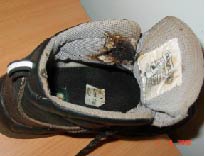Third degree burn sustained during rope access hot work
A member has reported an incident in which a rope access technician (RAT) suffered third-degree burns whilst engaged in hot work. The injured person was engaged in rope accessed structural cutting activity using an oxy-acetylene torch on a 20 inch pump caisson. During the operation sparks and molten material were blown in the direction of the injured party, and a small piece of molten material was caught in the tongue and ankle protector of his left safety shoe, causing serious burns to the left foot. The injured person was able to stop work, swiftly remove his safety shoe and safely descend to deck level using the rope access gear. Following initial first aid, it was noted that the burn was more serious than could be treated onboard and arrangements were made for the injured person to receive further treatment in hospital ashore.


The investigation revealed the following:
The direct cause of the incident was failure to use the correct personal protective equipment (PPE). Spat protectors were not readily available, partly due to inadequate organisation. These offer flame retardant protection to part of the under leg, ankle and shoe.
The root cause of the incident was inadequate procedures and standards of work.
- Procedures -specific details of hazards and precautions were not implemented in procedures for rope access hot work activities;
- Risk assessment -a full risk assessment for rope access-based hot work was not available and the job specific risk assessment used did not reflect any job specific issues;
- Permit to work (PTW) -the permit to work showed partially generic pre-setting on hazards and precautions with references to standard rather than specific job safety analysis (JSA);
- Job safety analysis -a specific job safety analysis was not available at the time of the incident;
- Toolbox talks (TBT) -the quality of toolbox talks was not sufficient and needed to be improved.
Following the incident, the following actions were taken:
- Arrangements were made to make spat protectors available as soon as possible;
- Investigated the use of more substantial protective equipment for persons doing hot work;
- Arranged for all appropriate worksite safety documentation (e.g. PTW, JSA and TBT records) to be available with specific detailed job-related entries;
- Investigated further training for personnel engaged in hot work, particularly flame-cutting.
Safety Event
Published: 27 September 2010
Download: IMCA SF 06/10
IMCA Safety Flashes
Submit a Report
IMCA Safety Flashes summarise key safety matters and incidents, allowing lessons to be more easily learnt for the benefit of all. The effectiveness of the IMCA Safety Flash system depends on Members sharing information and so avoiding repeat incidents. Please consider adding safetyreports@imca-int.com to your internal distribution list for safety alerts or manually submitting information on incidents you consider may be relevant. All information is anonymised or sanitised, as appropriate.
IMCA’s store terms and conditions (https://www.imca-int.com/legal-notices/terms/) apply to all downloads from IMCA’s website, including this document.
IMCA makes every effort to ensure the accuracy and reliability of the data contained in the documents it publishes, but IMCA shall not be liable for any guidance and/or recommendation and/or statement herein contained. The information contained in this document does not fulfil or replace any individual’s or Member's legal, regulatory or other duties or obligations in respect of their operations. Individuals and Members remain solely responsible for the safe, lawful and proper conduct of their operations.
